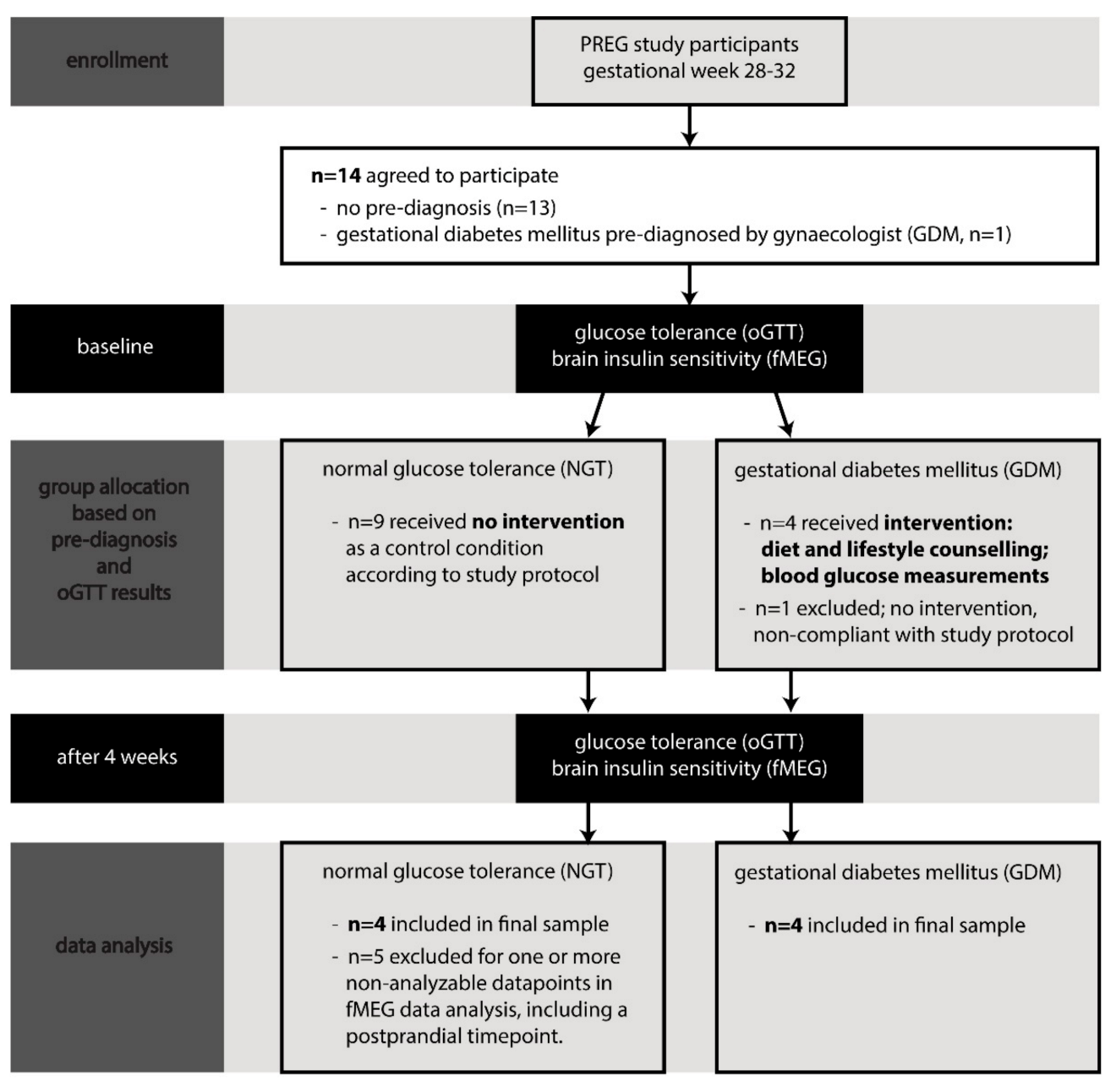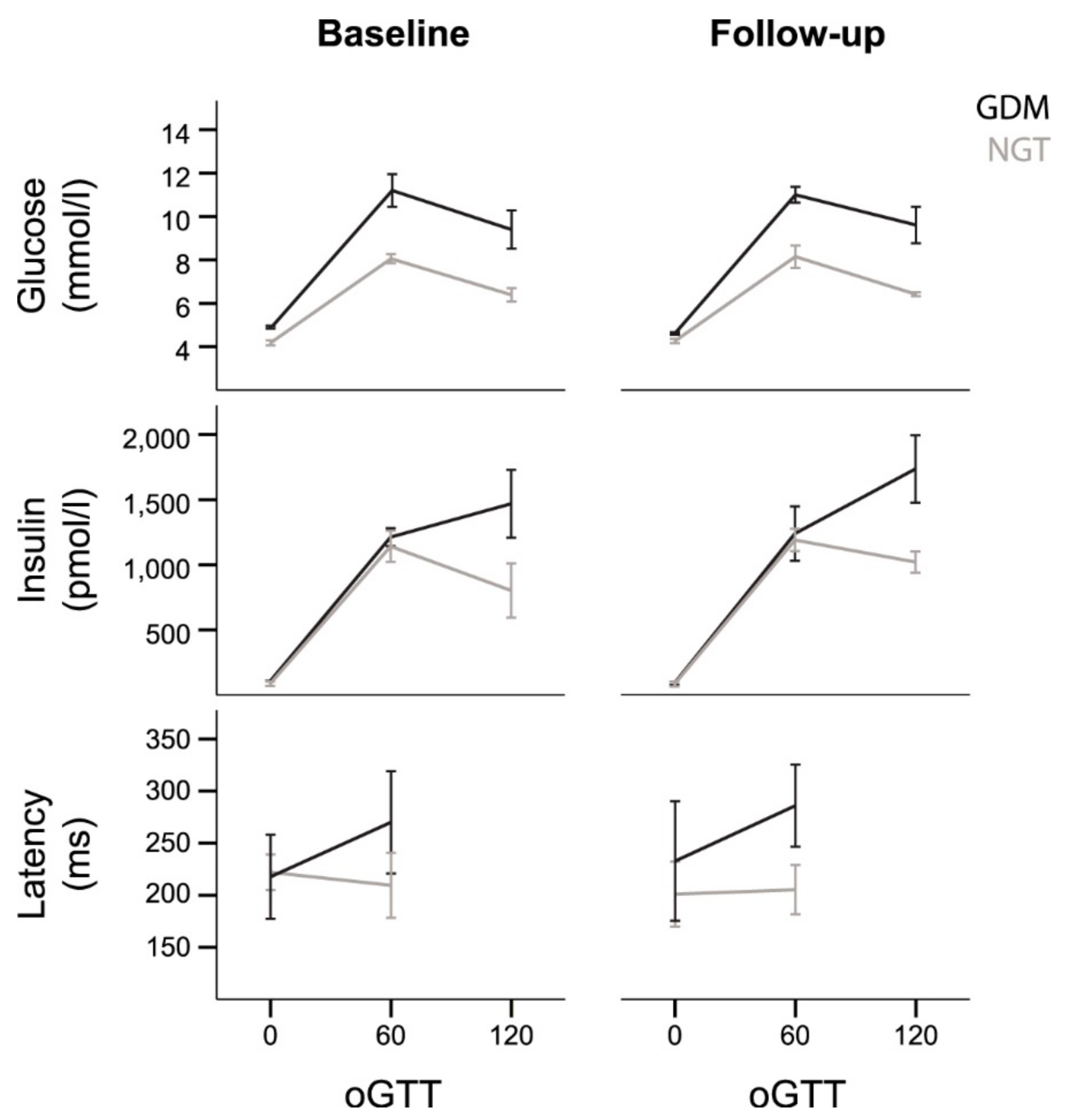No Effect of Lifestyle Intervention during Third Trimester on Brain Programming in Fetuses of Mothers with Gestational Diabetes
Abstract
1. Introduction
2. Materials and Methods
3. Results
3.1. Participants
3.2. Maternal Blood Glucose and Insulin Levels
3.3. Fetal Postprandial Brain Measurements
4. Discussion
Author Contributions
Funding
Institutional Review Board Statement
Informed Consent Statement
Data Availability Statement
Acknowledgments
Conflicts of Interest
References
- Lee, A.J.; Hiscock, R.J.; Wein, P.; Walker, S.P.; Permezel, M. Gestational Diabetes Mellitus: Clinical Predictors and Long-Term Risk of Developing Type 2 Diabetes: A retrospective cohort study using survival analysis. Diabetes Care 2007, 30, 878–883. [Google Scholar] [CrossRef]
- Bellamy, L.; Casas, J.-P.; Hingorani, A.D.; Williams, D. Type 2 diabetes mellitus after gestational diabetes: A systematic review and meta-analysis. Lancet 2009, 373, 1773–1779. [Google Scholar] [CrossRef]
- Langer, O.; Yogev, Y.; Most, O.; Xenakis, E.M. Gestational diabetes: The consequences of not treating. Am. J. Obstet. Gynecol. 2005, 192, 989–997. [Google Scholar] [CrossRef]
- Dabelea, D. The Predisposition to Obesity and Diabetes in Offspring of Diabetic Mothers. Diabetes Care 2007, 30, S169–S174. [Google Scholar] [CrossRef] [PubMed]
- Monteiro, L.J.; Norman, J.E.; Rice, G.E.; Illanes, S.E. Fetal programming and gestational diabetes mellitus. Placenta 2016, 48, S54–S60. [Google Scholar] [CrossRef]
- Stephenson, J.; Heslehurst, N.; Hall, J.; Schoenaker, D.A.; Hutchinson, J.; Cade, J.E.; Poston, L.; Barrett, G.; Crozier, S.R.; Barker, M.; et al. Before the beginning: Nutrition and lifestyle in the preconception period and its importance for future health. Lancet 2018, 391, 1830–1841. [Google Scholar] [CrossRef]
- Brown, J.; Alwan, N.A.; West, J.; Brown, S.; McKinlay, C.J.; Farrar, D.; Crowther, C.A. Lifestyle interventions for the treatment of women with gestational diabetes. Cochrane Database Syst. Rev. 2017, 5, CD011970. [Google Scholar] [CrossRef]
- Yamamoto, J.M.; Kellett, J.E.; Balsells, M.; García-Patterson, A.; Hadar, E.; Solà, I.; Gich, I.; Van Der Beek, E.M.; Castañeda-Gutiérrez, E.; Heinonen, S.; et al. Gestational Diabetes Mellitus and Diet: A Systematic Review and Meta-analysis of Randomized Controlled Trials Examining the Impact of Modified Dietary Interventions on Maternal Glucose Control and Neonatal Birth Weight. Diabetes Care 2018, 41, 1346–1361. [Google Scholar] [CrossRef]
- Linder, K.; Schleger, F.; Ketterer, C.; Fritsche, L.; Kiefer-Schmidt, I.; Hennige, A.; Häring, H.-U.; Preissl, H.; Fritsche, A. Maternal insulin sensitivity is associated with oral glucose-induced changes in fetal brain activity. Diabetologia 2014, 57, 1192–1198. [Google Scholar] [CrossRef] [PubMed]
- Linder, K.; Schleger, F.; Kiefer-Schmidt, I.; Fritsche, L.; Kümmel, S.; Heni, M.; Weiss, M.; Häring, H.-U.; Preissl, H.; Fritsche, A. Gestational Diabetes Impairs Human Fetal Postprandial Brain Activity. J. Clin. Endocrinol. Metab. 2015, 100, 4029–4036. [Google Scholar] [CrossRef] [PubMed]
- Kleinwechter, H.; Schäfer-Graf, U.; Bührer, C.; Hoesli, I.; Kainer, F.; Kautzky-Willer, A.; Pawlowski, B.; Schunck, K.; Somville, T.; Sorger, M. Gestational Diabetes Mellitus (GDM) Diagnosis, Therapy and Follow-Up Care. Exp. Clin. Endocrinol. Diabetes 2014, 122, 395–405. [Google Scholar] [CrossRef]
- Schäfer-Graf, U.; Laubner, K.; Hummel, S.; Gembruch, U.; Groten, T.; Kainer, F.; Grieshop, M.; Bancher-Todesca, D.; Cervar-Zivakovic, M.; Hösli, I.; et al. Gestationsdiabetes mellitus (GDM), Diagnostik, Therapie und Nachsorge—Praxisempfehlung—Kurzfassung der S3-Leitlinie (AWMF-Registernummer: 057-008). Diabetol. Stoffwechs. 2019, 15, S101–S111. [Google Scholar] [CrossRef]
- Baecke, J.A.; Burema, J.; Frijters, J.E. A short questionnaire for the measurement of habitual physical activity in epidemiological studies. Am. J. Clin. Nutr. 1982, 36, 936–942. [Google Scholar] [CrossRef]
- Draganova, R.; Eswaran, H.; Murphy, P.; Huotilainen, M.; Lowery, C.; Preissl, H. Sound frequency change detection in fetuses and newborns, a magnetoencephalographic study. NeuroImage 2005, 28, 354–361. [Google Scholar] [CrossRef]
- Hanson, M.; Gluckman, P.D. Developmental Origins of Health and Disease: New Insights. Basic Clin. Pharmacol. Toxicol. 2008, 102, 90–93. [Google Scholar] [CrossRef]
- Fleming, T.P.; Watkins, A.J.; Velazquez, M.A.; Mathers, J.C.; Prentice, A.M.; Stephenson, J.; Barker, M.; Saffery, R.; Yajnik, C.S.; Eckert, J.J.; et al. Origins of lifetime health around the time of conception: Causes and consequences. Lancet 2018, 391, 1842–1852. [Google Scholar] [CrossRef]
- Barker, M.; Dombrowski, S.U.; Colbourn, T.; Fall, C.H.D.; Kriznik, N.M.; Lawrence, W.T.; Norris, S.A.; Ngaiza, G.; Patel, D.; Skordis-Worrall, J.; et al. Intervention strategies to improve nutrition and health behaviours before conception. Lancet 2018, 391, 1853–1864. [Google Scholar] [CrossRef]
- Yong, H.Y.; Shariff, Z.M.; Yusof, B.N.M.; Rejali, Z.; Tee, Y.Y.S.; Bindels, J.; Van Der Beek, E.M. Independent and combined effects of age, body mass index and gestational weight gain on the risk of gestational diabetes mellitus. Sci. Rep. 2020, 10, 8486. [Google Scholar] [CrossRef] [PubMed]
- Tobias, D.K.; Zhang, C.; Van Dam, R.M.; Bowers, K.; Hu, F.B. Physical Activity Before and During Pregnancy and Risk of Gestational Diabetes Mellitus: A meta-analysis. Diabetes Care 2011, 34, 223–229. [Google Scholar] [CrossRef] [PubMed]
- Song, C.; Li, J.; Leng, J.; Ma, R.C.; Yang, X. Lifestyle intervention can reduce the risk of gestational diabetes: A meta-analysis of randomized controlled trials. Obes. Rev. 2016, 17, 960–969. [Google Scholar] [CrossRef] [PubMed]
- McIntyre, D.H.; Devlieger, R.; Van Assche, A.; Jans, G.; Galjaard, S.; Corcoy, R.; Adelantado, J.M.; Dunne, F.; Desoye, G.; Harreiter, J.; et al. Effect of Physical Activity and/or Healthy Eating on GDM Risk: The DALI Lifestyle Study. J. Clin. Endocrinol. Metab. 2017, 102, 903–913. [Google Scholar] [CrossRef]
- Zhang, C.-L.; Tobias, D.K.; Chavarro, J.E.; Bao, W.; Wang, D.; Ley, S.H.; Hu, F.B. Adherence to healthy lifestyle and risk of gestational diabetes mellitus: Prospective cohort study. BMJ 2014, 349, g5450. [Google Scholar] [CrossRef] [PubMed]


| Characteristic | NGT | GDM | p-Value (*) |
|---|---|---|---|
| Maternal age (years) | 32.3 ± 3.0 | 37.0 ± 3.7 | 0.11 |
| Gestational age (weeks) ** | 28.5 ± 1.0 | 28.8 ± 1.3 | 0.35 |
| Pregestational BMI (kg/m2) | 24.9 ± 2.3 | 28 ± 5 | 0.39 |
| BMI (kg/m2) ** | 28 ± 1.8 | 30.4 ± 4.3 | 0.39 |
| Relative weight gain (kg/week) ** | 8.6 ± 2.0 | 6.4 ± 2.2 | 0.20 |
| Weight gain between time points (kg/m2) | 1.25 ± 0.77 | 0.53 ± 0.85 | 0.20 |
| HPA Index ** | 7.5 ± 1.5 | 7.76 ± 0.47 | 0.20 |
| Parity (nulli-/multiparous) | 3/1 | 1/3 | 0.15 |
| C reactive protein (mg/dL) | 0.47 ± 0.38 | 0.69 ± 0.4 | 0.38 |
| HbA1c ** | 5 ± 0.1 | 5.4 ±0.1 | 0.03 |
| HbA1c increase between time points | 0.23 ± 0.19 | 0.05 ± 0.06 | 0.20 |
| Neonatal birth weight (g) | 3350 ± 272 | 3073 ± 584 | 0.39 |
| Category | Time Point | oGTT | NGT | GDM | p-Value (*) |
|---|---|---|---|---|---|
| Maternal glucose | Baseline | fasting | 4.2 ± 0.2 | 4.9 ± 0.1 | 0.029 |
| (mmol/L) | 1 h | 8.1 ± 0.4 | 11.2 ± 1.5 | 0.029 | |
| 2 h | 6.4 ± 0.6 | 9.4 ± 1.8 | 0.029 | ||
| After 4 weeks | fasting | 4.3 ± 0.2 | 4.6 ± 0.1 | 0.029 | |
| 1 h | 8.1 ± 1.0 | 11.0 ± 0.7 | 0.029 | ||
| 2 h | 6.4 ± 0.1 | 9.6 ± 1.7 | 0.133 | ||
| Maternal insulin | Baseline | fasting | 86 ± 32 | 105 ± 6 | 0.686 |
| (pmol/L) | 1 h | 1142 ± 240 | 1212 ± 137 | 0.486 | |
| 2 h | 802 ± 416 | 1469 ± 519 | 0.343 | ||
| After 4 weeks | fasting | 84 ± 37 | 91 ± 26 | 0.686 | |
| 1 h | 1190 ± 172 | 1240 ± 418 | 0.686 | ||
| 2 h | 1021 ± 114 | 1736 ± 517 | 0.267 | ||
| Fetal event-related | Baseline | fasting | 222 ± 34 | 218 ± 81 | 1.000 |
| response latency (ms) | 1 h | 209 ± 62 | 270 ± 98 | 0.486 | |
| After 4 weeks | fasting | 201 ± 62 | 232 ± 114 | 1.000 | |
| 1 h | 205 ± 47 | 286 ± 79 | 0.114 |
Publisher’s Note: MDPI stays neutral with regard to jurisdictional claims in published maps and institutional affiliations. |
© 2021 by the authors. Licensee MDPI, Basel, Switzerland. This article is an open access article distributed under the terms and conditions of the Creative Commons Attribution (CC BY) license (http://creativecommons.org/licenses/by/4.0/).
Share and Cite
Schleger, F.; Linder, K.; Fritsche, L.; Pauluschke-Fröhlich, J.; Heni, M.; Weiss, M.; Häring, H.-U.; Preissl, H.; Fritsche, A. No Effect of Lifestyle Intervention during Third Trimester on Brain Programming in Fetuses of Mothers with Gestational Diabetes. Nutrients 2021, 13, 556. https://doi.org/10.3390/nu13020556
Schleger F, Linder K, Fritsche L, Pauluschke-Fröhlich J, Heni M, Weiss M, Häring H-U, Preissl H, Fritsche A. No Effect of Lifestyle Intervention during Third Trimester on Brain Programming in Fetuses of Mothers with Gestational Diabetes. Nutrients. 2021; 13(2):556. https://doi.org/10.3390/nu13020556
Chicago/Turabian StyleSchleger, Franziska, Katarzyna Linder, Louise Fritsche, Jan Pauluschke-Fröhlich, Martin Heni, Magdalene Weiss, Hans-Ulrich Häring, Hubert Preissl, and Andreas Fritsche. 2021. "No Effect of Lifestyle Intervention during Third Trimester on Brain Programming in Fetuses of Mothers with Gestational Diabetes" Nutrients 13, no. 2: 556. https://doi.org/10.3390/nu13020556
APA StyleSchleger, F., Linder, K., Fritsche, L., Pauluschke-Fröhlich, J., Heni, M., Weiss, M., Häring, H.-U., Preissl, H., & Fritsche, A. (2021). No Effect of Lifestyle Intervention during Third Trimester on Brain Programming in Fetuses of Mothers with Gestational Diabetes. Nutrients, 13(2), 556. https://doi.org/10.3390/nu13020556






